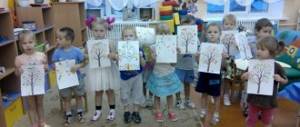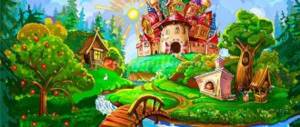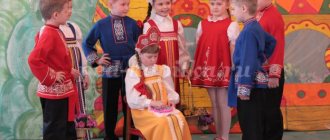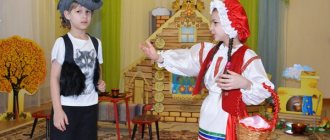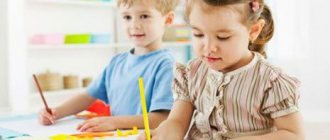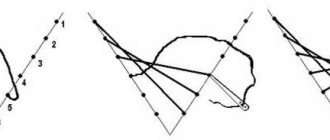Organization of the work of a theater group in a preschool educational institution
Introducing a child to the world around him through images, sounds, and colors is considered the most productive, allowing him to adapt to a social environment, while the leading activity for preschoolers is play.
Classes in the theater studio help children unleash their creative potential
The embodiment of artistic content in a playful form is the essence of theatrical activity (or theatrical play), the activities of which are concentrated in the framework of the work of a theater group. That is, the teacher conducts organized classes according to the program adopted and approved by the methodological council of the preschool educational institution at set hours.
Goals and objectives
The mission of the theater club at the preschool educational institution is aimed at:
- expansion of knowledge and introduction to art (kids get acquainted with the best examples of world literature, music, choreography);
- development of speech through cultivating the habit of expressive public speech;
- formation of emotionality (children learn to express their feelings, empathize, and show responsiveness);
- development of artistry (to promote the discovery of natural talents);
- fostering a tolerant attitude towards people;
- uniting the children's team.
Solving the following tasks helps achieve your goals:
- introduction to reading (individual, group) and analysis of what is read (highlighting the positive and negative qualities of characters, evaluating actions, etc.);
- acquaintance with various types of theater (on the table, horseback theater, wrist theater, floor theater, live puppets);
- practice of expressiveness of performing skills (through transformation into the image of a hero using facial expressions, gestures, intonation);
- improving the plasticity of movements;
Rhythmoplasty classes are an important aspect of the theater club program
- activation of the vocabulary of little actors, improvement of the sound culture of speech, dialogue form of communication;
- developing children's interest in theatrical and play activities (through acquaintance with the best examples of professional acting);
- fostering goodwill and peacefulness (mutual assistance between children in the process of work leads to good results).
Who works with children
Classes in the studio can be conducted by the following specialists:
- a teacher or additional education teacher who is no stranger to theatrical art (many theater studios are a kind of hobby for teachers);
- music worker (who also has an idea not only of the musical accompaniment of acting, but also of the laws of the stage);
- guest professional actor (actress, director).
Often, in kindergartens, theater clubs are taught by students from specialized universities, for whom this work is an excellent practice for mastery and at the same time a way to earn extra money.
Classes for children in the studio are conducted by people who find pleasure in transformations and public performances, and also have an understanding of the structure of the theater.
What do you need for work?
In kindergarten, preschoolers receive an understanding of the main types of theaters, which means that the work of the studio requires a systematic approach to organization. For classes you will need the following:
- Samples of puppets for various types of theater (bibabo, tabletop, finger theater on flannelgraph, etc.).
- Props for performing skits and performances (a set of dolls, screens for a puppet theater, costumes, costume elements, masks).
Children should be given the opportunity to try out the artistic possibilities of all types of theater, including shadow theater
- Attributes for various playing positions (theater props, makeup, books, scenery, director’s chair, scripts, samples of musical works, seats for spectators, posters, cash desk, tickets, “money”, license plates, fabrics, natural materials, paper of various colors and densities , paints, markers, glue, pencils, buttons, threads, boxes, jars).
During the club classes, children continue to get acquainted with musical instruments
How are classes organized?
Children aged 3–6 years old, that is, the second (in rare cases the first) junior, middle, senior and preparatory groups, are invited to participate in the theater club. The set is usually free, that is, everyone who wants to. In rare cases, a competition is held - when there are too many applicants.
The duration of the lesson, which is held 1-2 times a week in the afternoon, is determined by the age of the little actors:
- for 3-4 year olds - 15 minutes;
- for 4–5 year olds – 20 minutes;
- for 5-6 year olds - 25 minutes;
- for 6–7 year olds – 30 minutes.
This is interesting. Psychologists recommend conducting theater classes after a nap. This is due to the fact that special cognitive activity is not required from children, unlike lessons in the first half of the day.
Depending on the duration of the lesson and age group, the studio director selects the optimal set of techniques for working with children.
During classes, children often change activities: from acting to making decorations, which allows them to always stay busy
Theater studio "Mamin Sadik" (CAO)
Address: m. Tsvetnoy Boulevard, st. Karetny Ryad, 3 (Hermitage Garden) Website: https://mamin-sadik.ru Phone: Cost: from 1800 rub. for 1 lesson
Mikhail Plutakhin, an actor and director who studied at the Moscow Art Theater School-Studio - course of D. V. Brusnikin, teaches classes at the theater studio.
In this studio, at every lesson, children are engaged in acting training, speech, plastic exercises and stage sketches, pantomime, drawing and making scenery and props.
But the most important thing is that in the theater studio “Mama’s Sadik” they create such a creative, free and lively atmosphere where each participant in the process will definitely prove themselves, but at the same time learn to be part of the creative team.
During the classes, children become familiar with the basics of acting and the components of dramatic theater, and also learn to overcome shyness, develop communication skills, attention, empathy, the ability to work in a team, and a love of literature.
At the end of the course, a performance is staged: Italian fairy tales in the genre of Comedy Del Arte, in which children will immerse themselves in Italian culture, music, read Italian fairy tales, and prepare costumes and masks for themselves.
Techniques in the work of a theater group
Interaction with children in a theater club requires the teacher to have certain methodological skills that make it possible not only to maintain the interest of little students in the classroom, but also to stimulate them to co-creativity. To do this, you need to have a sufficient set of techniques, as well as know the age characteristics of the children who attend classes in order to competently combine different types of activities.
Visual techniques
Theater is the art of transformation, that is, children must see a model and, imitating it, find, with the help of a teacher, ways to play out the image in a new way. In this sense, visual techniques are valuable: observation and demonstration.
Watch puppet theater performances
Puppet theater performances are one of the most spectacular types of theatrical observation games for children 3–4 years old. With the help of performances where the characters are puppets (finger puppets, bibabo), children get acquainted with different plots and realize that the desired emotions can be achieved by pronouncing phrases with different intonations. For young theatergoers who are just mastering the capabilities of the speech apparatus, this practice is very useful. At the same time, the kids themselves remain only spectators and only at the end of the school year they try their hand at this type of games.
Demonstration is the main technique at the stage of getting to know the theater
Staging fairy tales and dramatizations
The demonstration is the final product of the theater class. Typically, children act out a story as a kind of final activity upon completion of studying a topic or block of topics. For example, after the children get acquainted with 3-4 folk tales, one of them is prepared for production.
This is interesting. Taking into account the age of the studio participants, for dramatizations one should choose plots with a large number of characters or play up all the stage elements: trees, flowers, etc.
As part of theatrical activities in classes at preschool educational institutions, it is recommended that performances be carried out starting from the middle group (rarely - the second youngest). But the studio program allows even three-year-olds to participate in group performances, for example, as supporting actors in productions with older children.
There should be no spectators in a theater studio; everyone has their own mission: select scenery, props, do makeup, sell tickets, etc.
Pictures and photos
Of course, you can’t do without the most accessible type of visualization. Illustrations should accompany the creative process at all its stages. As a visual aid, you can make a stand with photographs of performances and working moments - this will help the children evaluate the results of their work, which is important for reflection.
The entire creative process in the theater studio is accompanied by illustrations or photographs.
Verbal techniques
The main material for theatrical activities is the artistic word, which needs to be explained at a level that children can understand.
Conversation
First of all, this technique is used when discussing the plot of the work in question: from a nursery rhyme with kids to an author’s fairy tale with children 6–7 years old. Regardless of the age of the studio participants, the emotions experienced by the characters, readers, and listeners should be discussed in classes. If in the younger group the questions can be alternative (“Is the gray wolf from the fairy tale about “The Three Little Pigs” good or evil?”), then for older children problem tasks are more suitable (“Why do you think Thumbelina didn’t want to live with the Mole?”) .
It will be easier for children to answer questions if you accompany the tasks with illustrations of the work in question.
Stories
Another important technique, used mainly in the initial stages of developing a topic. Thus, it is appropriate to begin an introduction to theater in the first or second lesson with a story about this form of art, accompanied by pictures-illustrations or a multimedia presentation. The presentation of different types of theater and puppets also requires an explanatory monologue.
Interesting facts about the theater can make a story a great motivational device that will definitely interest kids. True, for children from 3 to 5 years old, verbal forms of motivation are inferior to visual ones. In other words, it is better to show the kids the Parsley doll than to tell them that he appeared thanks to traveling artists - buffoons. But it will be funny for older preschoolers to hear that in Italy, in Sicily, there are theatrical performances that last... for a month.
Reading
The teacher’s example will help to introduce children to reading. In theater classes, as in any “adult” theater, readings are practiced, that is, discussion of the actions of the characters as the plot develops. However, this technique can only be used if the circle members can read at approximately the same level. For children who do not yet master this skill, readings are replaced by repeated listening to the text.
Reading aloud for theatergoers of primary preschool age is an important verbal technique
Poems, riddles
These traditional techniques in working with children can also be used in the activities of a theater group. Thus, as children get acquainted with the characters of literary examples, they can offer riddles, which, among other things, allow the teacher to find out the children’s level of mastery of the material.
- He is with a bell in his hand, wearing a blue and red cap. He is a funny toy, And his name is... (Parsley).
- Fruit and vegetable garden country - In one of the fairy tales there is it, And in it the hero is a vegetable boy, He is brave, fair, mischievous. (Cipollino).
- My father has a strange boy, unusual, wooden, on land and under water, looking for a golden key, sticking his long nose everywhere... Who is this? (Pinocchio).
Regarding poems, there is no better way to practice the expressiveness of speech, which is directly related to success in the theatrical field. Usually, the studio’s work plan includes a lesson (sometimes even an open one) in which children read poems united by one theme. For example, at an event dedicated to March 8:
- I'll get up early in the morning and kiss my mother. I'll give you a bouquet of flowers - There is no better mother in the world!
- What an elegant Kindergarten! This is mother's holiday for the guys. We will sing a song for mom, we will start a dance for mom.
- On the Eighth of March I will draw my mother a Blue Sea and a Sky with clouds. Next to this sea, dressed in foam, I will draw a mother with a festive bouquet.
Expressiveness of speech is one of the indicators of its quality
Practical techniques
Practical techniques include methods for practicing acting skills.
Sketches
Etudes are exercises aimed at developing the expressiveness of a child’s performing skills. Completing such tasks usually begins at the age of 4, when children already have a basic understanding of the essence of theatrical performance. For example, the youngest studio participants are delighted with the task “Drawing on the fence.” Each child takes turns drawing any object on the “fence” (wall of the room), and the other children guess what is depicted, and also make sure that the drawing does not interfere with the previous picture. Preschoolers also like the task “Assemble a picture”: the kids receive sets of geometric figures, the teacher shows an image (for example, a dog, a horse), and the children lay out these drawings from the figures that are given.
For children 4–7 years old, the task may be associated not only with the activation of performing skills, but also with the formation of skills in simple arithmetic operations. For example, “Show a number”: children take the pose of a number, and then become an “example”, using their hands as a plus or minus sign. An analogue of the mathematical game is the letter game - “Show the letter.”
Sketches for children are a kind of game that they enjoy participating in
Exercises for social-emotional development
The essence of the tasks is to learn to correlate sounds with a situation, character, and emotions. In the younger group, this will be an elementary task of connecting onomatopoeic words (“muu”, “meow”, etc.) with the animal that pronounces these sounds. For older children, the test could be this: one of the participants stands with his back to the children, and everyone else, imagining that he is lost in the forest, takes turns calling him with different emotions: “Awww... Bogdan!” The child standing with his back must guess from the voice who is calling him.
Psycho-gymnastics
Psycho-gymnastic exercises develop reflection in children. As tasks, it is usually asked to imagine a certain image accompanied by appropriate music: a hike in the forest to the sounds of nature, a sweet dream to the sound of the sea, etc. At the same time, according to the instructions, the state changes: the forest becomes denser, mosquitoes fly in, a wolf howls are heard, or the wind blows , threw sand on the beach, it started to rain, etc. As a rule, such reflective exercises are also arranged as physical education minutes in class.
The skill of changing emotions by setting in adult artists is considered aerobatics, but children usually cope with this task quite easily
Tongue Twisters
This technique is used to practice diction and clarity of pronunciation:
- Sasha walked along the highway and sucked on a dryer.
- Senka is carrying Sanka and Sonya on a sled.
- Six little mice rustle in the reeds.
- Whey from yogurt.
- The wasp settled on the nose, I will take the wasp to the branch.
In older preschool age, tongue twisters can be complicated by a dialogue form:
- - Tell me about your purchases. — What kind of shopping? - About shopping, about shopping, about your shopping.
- The mouse whispers to the mouse: “You keep rustling, you’re not sleeping!” The mouse whispers to the mouse: “I will rustle more quietly.”
- The crab made a rake for the crab, The crab gave the rake to the crab: - Rake the gravel, crab!
This is interesting. By the age of two, children master the sounds: a, o, e, p, b, m. By three years, the list expands to i, s, y, x, f, v, t, d, n, k, g, x, y. The four are added to the scale: s, z, c, w, zh, h, shch. At five years old, kids cope with l, r.
Tongue twisters are part of articulatory gymnastics, which is a mandatory component of classes in preschool educational institutions.
A game
Most of the techniques used in the work of a theater group, one way or another, involve play - the leading activity of preschoolers. But if we talk about the gaming technique in its “pure” form, then here it is mainly fun that develops performing skills (in the youngest children) and contributes to social-emotional development (in older children).
Table: examples of games in theater classes
| Age | Name of the game | Goals | Description |
| 3–4 years | "Mirror" |
| Children in pairs stand opposite each other, one slowly makes movements, and his “reflection” repeats them. Change roles. |
| 5–7 years | "Magic wand" |
| The teacher shows the children an object (for example, a pen), the kids must take turns saying what this pen could be: a worm, a microphone, etc. To make it more difficult, you can ask the children to show their answers rather than name them. |
| "Gossip" | Develop:
| The participant says some phrase on the topic in the ear of a friend, he guesses and makes his phrase to the next one. |
Work program for a theater studio in kindergarten
The program used in the theater studio is an original development, compiled on the basis of the age characteristics of the circle participants and taking into account connections with other educational courses at the preschool educational institution. As a rule, recruitment to the studio occurs once every year or two, but with the possibility of additional recruitment as needed. In some kindergartens, the theater club program lasts 4 years. This is usually done when classes are taught by professional theater workers (actors, directors of local theaters) as part of municipal theater cooperation programs with educational institutions.
Usually, staging a fairy tale is a kind of result of the circle’s work over a certain period.
Typically, the work plan is designed for one lesson per week with children of the same age group. However, such clubs, as a rule, are organized by the teacher himself, who is no stranger to theatrical activities. If classes are taught by a teacher of additional education, an actor, or a director, then one lesson per week is also planned, but with children of different ages.
This is interesting. The division by age can be older (5–7 years old, that is, senior and preparatory groups) and younger (3–5 years old—junior and middle groups).
By older preschool age, children, as a rule, have already decided on the role they would prefer to play in productions: actor, director, decorator, etc.
Table: example of a theater club work program for the senior group (fragment)
| Author | Chereshneva A.V., teacher of MBDOU No. 9 “Vasilyok”, Gryazi, Lipetsk region | ||||
| Name | "Merry booth" | ||||
| Month | date | Subject | Theory | Practice | Other types of work |
| September | In the world of theater (toy theater, pictures on flannelgraph) | Conversation about types of theaters:
| Lesson “Visiting the brownie Kuzi.”
|
| |
| Tabletop toy theater | Ways to use a variety of toys - factory-made and homemade. |
|
| ||
| Tabletop picture theater | Features of making characters and decorations (double-sided with support). |
|
| ||
| Theater of toys or pictures on the table |
|
|
| ||
| Quote from: https://dohcolonoc.ru/kruzhkovaya-rabota/3767-plan-raboty-teatralnogo-kruzhka-veselyj-balaganchik.html | |||||
Table: example of a work program for a theater club for primary preschool age (fragment)
| Author | Patrakova T. N., teacher of the Osinovsky kindergarten, Osinovo village, Nikolsky district, Vologda region | |
| Name | "Theater for kids" | |
| Month | Subject | Tasks |
| September |
|
|
| October |
|
|
| November |
|
|
| December |
|
|
| January | Weeks 1–2: finger games based on fairy tales. |
|
| February |
|
|
| Quote from: https://lesson.rf/library/plan_raboti_kruzhkovoj_deyatelnosti_teatr_dlya_malish_114831.html | ||
Table: example of a theater club work program for the first junior group (fragment)
| Author | Oleinik S.V., teacher of MKDOU Kindergarten No. 1, p. Buturlinovka, Voronezh region |
| Name | "Teremok" |
| Month | The content of the work |
| October |
|
| November |
|
| Quote from: https://nsportal.ru/detskiy-sad/raznoe/2016/11/12/rabochaya-programma-kruzhka-po-teatralizovannoy-deyatelnosti-teremokv | |
MAGAZINE Preschooler.RF
Work program for the circle activity “Theater Chest” in the senior groupMunicipal budgetary preschool educational institution "Novotoryalsky kindergarten "Teremok"
Developed by: teacher Biryukova M.I. New Toryal 2020
Explanatory note
Artistic and aesthetic education occupies one of the leading places in the content of the educational process of a preschool institution and is its priority direction. For the aesthetic development of a child’s personality, a variety of artistic activities are of great importance - visual, musical, artistic and speech, etc. An important task of aesthetic education is the formation in children of aesthetic interests, needs, aesthetic taste, as well as creative abilities. Theatrical activities provide a rich field for the aesthetic development of children, as well as the development of their creative abilities. Theater activities help develop the child’s interests and abilities; contribute to overall development; manifestation of curiosity, desire to learn new things, assimilation of new information and new ways of action, development of associative thinking; perseverance, determination, manifestation of general intelligence, emotions when playing roles.
The work program was developed based on the program of the theater club according to the Federal State Educational Standard at school and in kindergarten.
The goal of the work program is to develop children's creative abilities through the means of theatrical art.
Tasks:
- Creating conditions for the development of the creative potential of each participant in production activities.
- Improving artistic skills in terms of experiencing and embodying images and performing skills of children.
- Formation of the simplest figurative and expressive skills, learning to imitate fairy-tale animals.
- Activation of vocabulary, improvement of the sound culture of speech, intonation structure, and skills in conducting dialogues.
- Teaching elements of expressive means of artistic and figurative type (facial expressions, intonation, pantomime).
- Developing interest in staged and playful activities.
Forms of working with children:
- a game
- staging and dramatization
- children's story
- teacher reading
- conversations
- learning works of oral folk art
- discussion
- observations
- verbal, board and outdoor games.
Principles of conducting theatrical activities:
The principle of adaptability, providing a humane approach to the developing personality of the child.
The principle of development, which involves the holistic development of the child’s personality and ensuring the readiness of the individual for further development.
The principle of psychological comfort. It assumes the psychological security of the child, providing emotional comfort, creating conditions for self-realization.
The principle of a semantic relationship to the world. The child realizes that the world around him is a world of which he is a part and which he somehow experiences and comprehends for himself.
The principle of systematicity. It assumes the presence of unified lines of development and education.
The principle of the orienting function of knowledge. The form of knowledge presentation should be understandable to children and accepted by them.
The principle of mastering culture. Ensures the child’s ability to navigate the world and act in accordance with the results of such orientation and with the interests and expectations of other people.
The principle of learning activities. The main thing is not the transfer of ready-made knowledge to children, but the organization of such children's activities, during which they themselves make “discoveries” , learn something new by solving available problematic problems.
Main directions of the program:
1. Theatrical and gaming activities. Aimed at developing children's play behavior, developing the ability to communicate with peers and adults in various life situations.
Contains: games and exercises that develop the ability to transform; theatrical games to develop imagination and fantasy; dramatization of poems, stories, fairy tales.
2. Artistic and speech activity. Combines games and exercises aimed at improving speech breathing, developing correct articulation, intonation expressiveness and speech logic, and preserving the Russian language.
Contents: exercises for the development of speech breathing, diction, articulatory gymnastics; games that allow you to form intonation expressiveness of speech (learn to use different intonations), expand the figurative structure of speech; games and exercises aimed at improving speech logic.
3. Fundamentals of theatrical culture. Designed to provide conditions for preschoolers to acquire basic knowledge about theatrical art:
- What is theater, theatrical art;
- What kind of performances are there in the theater?
- Who are the actors;
- How to behave in the theater.
Organization of activities and mode of the circle:
The circle is held once a week - Thursday, 4 times a month in the afternoon at 15.40-16. 05h., duration 25 minutes.
Preparation requirements.
The theater club program (according to the Federal State Educational Standard) assumes that at the end of the classes the child will be able to:
- Interested in performing and acting activities.
- Perform simple performances based on literary works and plots known to him using expressive figurative means (gestures, facial expressions, intonation).
- Perform in front of children and parents with performances.
- Depict answers to riddles using expressive means.
Calendar-thematic
planning club activities
October
1. Topic. Introduction to the concept of theater (showing slides, paintings, photographs).
Purpose: to give children an idea of the theater; cultivate an emotionally positive attitude towards the theater.
2. Topic. Introduction to theatrical professions (artist, make-up artist, hairdresser, musician, decorator, costume designer, actor).
Goal: to form children’s ideas about theatrical professions; to intensify interest in theatrical art; Expand words knowledge.
3. Theme. How to behave in the theater.
Goal: familiarization with the rules of behavior in the theater. Expand children's interest in active participation in theatrical games.
4. Theme. Plot-role-playing game "Theater" .
Goal: to arouse interest and desire to play (play the role of “cashier” , “ticketer” , “spectator” ); cultivate friendly relationships.
November
1. Topic. Getting to know the types of theaters.
Goal: to introduce children to different types of theaters; deepen interest in theatrical games; enrich your vocabulary.
2. Topic. "To grandma's village."
Goal: to involve children in the game plot; activate auditory perception, encourage motor and intonation imitation; learn to act with imaginary objects. (N.F. Gubanova “Theatre. Activity School” p.84)
3. Theme. A. Barto “Toys” , jokes.
Goals: to develop interest and respect for toys; maintain the desire to listen to poetry and answer the teacher’s questions. To develop the ability to convey basic emotions through facial expressions, gestures, and movements. (N.F. Gubanova “Theater activities for preschool” p.47)
4. Theme. Tales from the chest.
Goal: introduce children to a new fairy tale; teach her to listen carefully, encourage her to act out the fairy tale she likes in plastic sketches. (N.F. Gubanova “Theatre. Activity School.” p. 181)
December
1. Topic. Reading the fairy tale “Under the Mushroom” .
Goal: develop attention, perseverance; stimulate children's emotional perception of fairy tales; foster friendly relationships between children.
2. Topic. Distribution of roles in the fairy tale “Under the Mushroom” .
Goal: to create a desire to participate in games - dramatizations; lead children to create an image of a hero using facial expressions, gestures, movements; cultivate friendly relationships.
3. Theme. Practicing roles. Work on facial expressions during dialogue, logical stress.
Goal: to continue to form the emotional expressiveness of children’s speech;
4. Theme. Performance with the fairy tale “Under the Mushroom” in front of the kids.
Goal: to teach children to take on the roles of fairy-tale characters; develop performing skills through imitation of animal habits.
January
1. Topic. Winter fun.
Goal: to create an atmosphere of magic; teach children to invent game situations; to please and captivate children in a gaming situation. (N.F. Gubanova “Theatre. Activity School” p. 175)
2. Topic. Game exercises “Understand me” , “Change your voice” .
Goal: to develop attention, memory, observation, imaginative thinking in children.
3. Theme. Culture and technique of speech. "Funny Poems"
Goal: learn to pronounce phrases in different intonations (sad, happy, angry, surprised).
February
1. Topic. Introduction to tabletop theatre. Mastering the skills of mastering this type of theatrical activity.
Goal: continue to introduce children to puppet theater; skills in mastering this type of theatrical activity; cultivate a love for the theater.
2. Topic. Reading the fairy tale "Turnip".
Goal: continue to teach listening to fairy tales; develop associative thinking, attention, perseverance; foster positive relationships between children
3. Theme. Distribution of roles. Work on speech.
Goal: to teach children to negotiate amicably and consistently; foster a sense of collective creativity; measure your capabilities, develop speech breathing, learn to use intonation, improve diction.
4. Theme. A dramatization of the fairy tale "Turnip". (table theater - for children in their group).
Goal: to teach children to take on roles; portray the heroes of a fairy tale; cultivate artistic qualities.
March
1. Topic. Acquaintance with the type of theatrical activity - mask theater.
Goal: to continue to introduce children to the type of theatrical activity - mask theater; develop creative interest.
2. Topic. Reading of the poem by V. Antonova “The gray bunnies are sitting.” Preparation of masks (each child prepares a mask for himself and paints the finished blank).
Goal: to develop children’s ability to independently make attributes; cultivate accuracy in work; develop creativity and imagination.
3. Theme. Preparing a performance based on a poem.
Goal: develop the ability to build dialogues between characters; develop coherent speech; develop confidence; expand the figurative structure of speech; monitor the expressiveness of the image.
4. Theme. Staging of the play “The Gray Bunnies Are Sitting” “for your group.”
Goal: create conditions for the manifestation of your individuality; to develop artistry in children.
April
1. Topic. Entertainment Smile kids"
Goal: to arouse interest in the holiday characters. Give children joy and pleasure from the holiday.
2. Topic. Fairy tale "Zayushkina's hut" . Introduction to the characters of the fairy tale, distribution of roles.
Goal: to develop imagination, imagination, memory in children; ability to communicate in the given circumstances; experience the joy of communication.
3. Theme. Rehearsal of the play based on the fairy tale “Zayushkina’s Hut” .
Goal: to develop expressiveness of gestures, facial expressions, voice; replenish your vocabulary.
4. Theme. Rehearsal of the play based on the fairy tale “Zayushkina’s Hut” .
Goal: to develop a sense of rhythm in movements, speed of reaction, coordination of movements; improve motor ability and plastic expressiveness; expand the range due to the sound of the voice.
May
1. Topic. Screening of a performance based on the fairy tale “Zayushkina’s Hut” (for parents).
Goal: create a positive emotional mood; develop a sense of self-confidence; introduce children to the art of theater.
2. Topic. Theater games. Articulation gymnastics;
Goal: develop playful behavior, readiness for creativity; We develop communication skills, creativity, and confidence.
3. Theme. "Games with Grandma Zabavushka"
Goal: creating gaming motivation. Develop correct speech breathing; improve motor abilities and plastic expressiveness.
Bibliography
- G.V. Laptev “Games for the development of emotions and creativity . Theater classes for children 5-9 years old. S.-P.: 2011
- N.F. Gubanov “Theatrical activities of preschool children.”
- A.N. Chusovskaya “Scenarios for theatrical performances and entertainment” M.: 2011.
- 3. Artemova L. V. “Theatrical games for preschoolers” M.: 1983.
- GA. G. Raspopov “What kind of theaters are there?” Publishing house: School Press, 2011.
| Next > |
Conducting classes in a theater group at a preschool educational institution
Like any other type of educational activity in a preschool educational institution, theater studio classes are carefully planned, which is reflected in the summary of theatrical activities. It is compiled based on the time allotted for a lesson for a specific age group. In general, the structure of the lesson looks like this:
- Introductory stage: updating basic knowledge, motivating children to work (2–5 minutes).
- The main part of the lesson: conversations on the topic, staging sketches, acting out skits, reading with discussion, games, practicing dramatization (5-20 minutes).
- Final stage: assessment of each child’s work by the teacher, reflection (2–5 minutes).
The more detailed the lesson notes are, the greater the chances that the work will be productive and well organized.
Table: example of a lesson plan for a theater club for children of senior preschool age (fragment)
| Author | Romanova G.V., musical director of MBDOU D/s No. 49, Novocherkassk, Rostov region | ||
| Subject | "Visiting Petrushka" | ||
| Target | To create conditions for the development of musical and creative abilities of children of senior preschool age through theatrical activities. | ||
| Tasks |
| ||
| Equipment |
| ||
| Repertoire |
| ||
| Progress of the lesson | Introductory part | Main stage | Conclusion |
Parsley (sad): Good morning! (if the children do not pay attention to Parsley’s mood, then ask if they know what happened to Parsley). Music leader (M/R): Hello, dear Petrushka! What about him? I don't know. Expressive movements: eyebrows are raised, the corners of the mouth are lowered, the shoulders are raised for a moment, the arms are slightly spread, the palms are open. Children:... M/R: Show with facial expressions what mood Parsley is in. Parsley: I’m in a bad mood, I’m very sad, sad. M/R: So that's what it's all about! Guys, what should we do? The teacher’s use of students’ previously acquired knowledge (preliminary work, content of various types of activities). Children: Sing a song, dance, play. Show me a fairy tale... Petrushka mutters something inaudibly. M/R: I don’t understand anything. Guys, what did he mutter?
Listen to how our guys clearly pronounce tongue twisters. And you can learn this way.
Children pronounce tongue twisters at different paces with different dynamics. Parsley tries to repeat it, but nothing works. | Parsley: And I also know the tongue twister. Chickens cluck in the courtyards - cluck-cack-cack. Children pronounce the new tongue twister slowly, then increase the pace. M/R: And again: we start quietly, then loudly! With the movement of my hand, they started! (Children say the tongue twister several times). Amazing! Well done! Say the tongue twister angrily, scared, joyfully, sadly, crying, laughing, timidly, cunningly. Children pronounce a tongue twister. Parsley: And I said the tongue twister better than anyone else! I'm the best! I am better! M/R: Oh, what happened to Petrushka? What has he become? Show with facial expressions how much of a troublemaker Parsley has become. Wow! Children show. Parsley: Oh, oh, oh! I'm so ashamed, I won't do this again! Out of shame, I even forgot what type of puppet theater I belonged to. Can you advise me! (Children's answers). Thank you, I remembered everything! I live in a dollhouse of riding dolls on the gapite. Parsley asks the children a riddle.
| Parsley: Thank you, you're welcome! And they made me laugh! I liked it very much! What did you like about the performance? What are you happy with? What do you remember? Come see me again, I will be very glad to see you! | |
| Quote from: https://www.maam.ru/detskijsad/konspekt-zanjatija-teatralnogo-kruzhka-v-gostjah-u-petrushki-muzykalnogo-rukovoditelja-mbdou-ds-49-romanovoi-gv.html | |||
